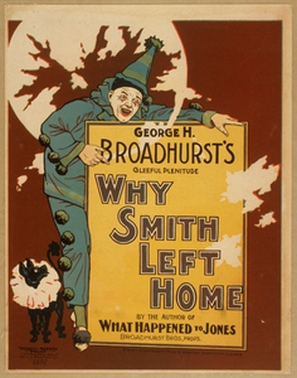Dorothy Usner's naughty photographs
My research into the early history of motion pictures in Australia at some point took me to Jack Cato's book The Story of the Camera in Australia; regrettably, there are so many errors in his version of events that nothing in the book can be taken for granted. As a test of the material that is not (at first appearances) related to motion pictures I decided to check the accuracy of his story about photographer Henry Walter Barnett's photographs of American actress Dorothy Usner.
On page 91 of the book, in his somewhat overly enthusiastic appraisal of Barnett, Cato relates the following about him:
During a slump period he took a window in the heart of Sydney, dressed it in the most expensive fabrics, and placed only four photographs under a spotlight in the centre of it. This cost £400. Soon Walter felt big enough to shock the locals. He made a picture of the actress Dorothy Usner as "Spring", in a drape so fine and transparent that she was completely nude. Sydney had never seen anything like this before and despite the sermons preached about it they enjoyed it. This show cost Walter only £42.How much of this tale is true?
|
Dorothy (originally Dora) Usner was born on 30 August 1873 at Belleville, Illinois, USA. She arrived at Sydney, New South Wales, Australia on 23 July 1896 on board the ship Alameda from San Francisco, California as one of the members of Nat C. Goodwin's theatre company, which had been booked by J. C. Williamson and George Musgrove to perform at several venues in the Australian colonies. They straightaway took the train to Melbourne, Victoria to open at the Princess' Theatre there on the night of 25 July. There are various references to Ms Usner in Australian newspapers of the time. One of the longest is from Melbourne's The Champion of 8 August: An additional lady member of the company appears in the caste in the person of Miss Dorothy Vsner. [sic] She is petite, pleasing, and pretty, with a slumbrous drawl as fascinating as it is provoking. Sweet speeches and the cooings of love arrive slightly too slowly by such transit, and it would be hopelessly behindhand with a repartee. But it sounds true to life, and, furthermore, it is true to life. On 20 August Melbourne Punch published a photograph, a detail from which is reproduced on the right, of her as the character Lucy in Sheridan's play The Rivals. This photograph was from the Falk Studios, which was Henry Walter Barnett's business, and in all likelihood was taken under his supervision. Another Falk photograph of her appeared in Melbourne Punch on 10 September. On 3 September Melbourne Punch's Lady's Letter included: Quite a swagger function was the Violet Ball in spite of the rain, which poured on Friday [28 August] evening as if a second deluge were on tap. Beautiful as were the decorations and the raison d'etre of the dance, the visitors were much more attractive, particularly one lovely and recently arrived artiste from America. [...] The charming artiste was the envy of the women and the admiration of the men, many of whom had heard that she has been passing her mornings posing for the semi-"altogether." [...]Dorothy Usner is not named, but other newspaper reports of the Violet Ball note her presence there. At the end of August 1896 Nat Goodwin's company went to Adelaide, South Australia, but Dorothy Usner did not accompany them, having decided to leave the group. Melbourne's Table Talk of 11 September commented: MISS Dorothy Usner did not go on with the Goodwin company to Adelaide, but remained in Melbourne with some friends. Her trip to Australia is principally for pleasure.There was later mention that she had had offers from Australian managers, and that she would appear in other shows, but there is nothing obvious that she made any further stage appearance in Australia. She returned to Sydney on 22 September 1896 and on 28 September left there for San Francisco on board the R.M.S. Monowai. (It was another month before Nat Goodwin and the rest of the company left Australia.) |
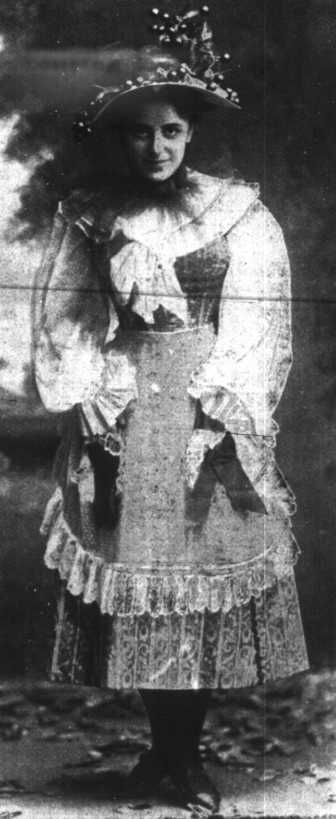 Dorothy Usner as Lucy in The Rivals (Not naughty) Image courtesy of the National Library of Australia
|
Melbourne's Free Lance of 5 September 1896:
Dorothy Usner, of the Nat Goodwin Co., is reckoned by camera-men, like Falk and Marceau, of Murka, and Falk, of Australia, to be about the best subject they have met. The young lady has extraordinary control over her facial expression, [...].Sydney's The Sunday Times of 6 September 1896:
Miss Dorothy Usner, of the Nat Goodwin Company, is the favorite subject with the photographers.the Sydney Mail of 23 January 1897:
Miss Dorothy Usner, who came over with Mr. Nat Goodwin from America, but left him during the Melbourne season and returned to the States, is suing her late manager for slander. He told an interviewer that portraits she had taken of herself were immodest, and that this was the reason for her leaving the company.The Sunday Times of 24 January 1897:
Miss Dorothy Usner has commenced a libel action against Nat Goodwin for telling an American interviewer that if her photos, taken in Melbourne, were exhibited in New York, she would be arrested.and Melbourne Punch of 28 December 1899:
IN the last number of The Broadway Magazine Miss Dorothy Usner, who visited you with Nat Goodwin, has an article on how to succeed on the stage, illustrated with the beautiful art photos of herself that Walter Barnett took at the Falk Studios in Melbourne, and which she has had labelled as being 'taken from poses suggested by herself,' and copyrighted by her some years ago. [...]
After she had returned to the USA, The Sportsman (of Melbourne) teased its readers with:
A few people know something about that posing photographically for the "Altogether" – but they "ain't a-going to tell."(This may not refer to Dorothy Usner.) ("I Ain't Agoin' to Tell" is the name of a then-popular comic song.)
But some months later, on 13 January 1897, Melbourne's The Age spilled the beans:
A legal suit in which Melbourne playgoers will take an interest is pending in the New York Courts. It arises out of the recent visit of Mr. Nat C. Goodwin and his dramatic company to these colonies. [...] He brought with him originally two very competent actresses in the persons of Miss Blanche Walsh and Miss Dorothy Usner, who, after appearing in one or two plays, became superfluous on the arrival of the sisters Elliott. Miss Walsh returned to America and Miss Usner resigned, but stayed on in Melbourne for a time. Both ladies, however, on arrival at San Francisco, spoke in very disparaging terms of Mr. Goodwin's treatment of them, and of his non-success in Australia. The comedian on returning to America took steps to remove the impression which the statements of the two ladies had created. He not only denied the truth of their assertions, but went further, particularly in the case of Miss Usner, who seems to have been most vigorous in her denunciation of Mr. Goodwin. In various press interviews he alleged that she was discharged for incompetence and indecent conduct; [...] that she posed for pictures which would cause her arrest if shown in New York; [...]. Miss Usner, who appeared to be an unassuming, painstaking and very intelligent young lady on the stage while in Melbourne, naturally feels very much aggrieved at these aspersions on her personal and professional character, and she has started an action for slander against Mr. Goodwin, claiming something like £5000 damages. [...](She later abandonned the suit.)
And considerably later, on 12 August 1897, about one year after the event, Melbourne Punch let it be known:
MISS DOROTHY USNER, whose remarkable photographic studies caused so much talk in Melbourne last year, is playing lead in The Girl from Paris at N.Y. Herald Square Theatre.
If the photographs were "remarkable" why weren't they remarked upon in the newspapers at the time?
On 14 October 1897 Melbourne Punch's Lady's Letter stated:
Dorothy Usner, whose portraits in gossamer garments, with a background of blossoms, used to shock old-fashioned Melbourne people, has been romancing to an American newspaper. [...]
If the photographs were considered immodest or indecent, it may well have been outside the prevailing social norms to openly discuss them, and, probably more importantly, to advertise their existence. In fact, it appears that the only time such matters were mentioned in the newspapers was in the law, police, and court reports. And, curiously, there was an event that occurred in Sydney when Usner was in the country that has an echo of Cato's story. Sydney's The Daily Telegraph had the following in their "Police Courts" section of 8 September 1896:
A man named Percy D. Hepburn was proceeded against at the Central Court yesterday, before Mr. Edwards, S.M., on a charge of exposing an indecent exhibition to the public view at 165 King-street. It was stated that an exhibition of the Rontgen or X rays was given at this place, during which a nude figure was shown. Accused was committed for trial at the forthcoming Court of Quarter Sessions. ...The Bulletin of 19 September added some detail:
The police charge against the Sydney alleged X-ray man, ... is that he exposed to view a nude female under the pretence of a scientific exhibition.(He was later acquitted.)
It thus appears that some elements of Cato's story are true. Photographs of Dorothy Usner – who took them is not known, although it was almost certainly H. Walter Barnett – appear to have caused some discussion in Melbourne, though there is no evidence that they did so in Sydney. As for the money figures of £400 and £42, is it possible now to find out if these are correct or not? We can ask why (and how) Cato remembered them, especially considering the precision of the latter. As Cato was only 7 years old at the time he obviously learnt everything about Dorothy Usner's visit to Australia from someone else, presumably Barnett.
It seems that a few of the "offending" photographs made it into mass circulation:
on page 24 of the 27 June 1897 issue of the New York World
newspaper are heavily-retouched copies of images attributed to H. Walter
Barnett, entitled Studies in Artistic Photography
, showing Dorothy Usner
in various poses and as various characters.
Three of these indeed show Ms Usner in gossamer garments, with a background
of blossoms
, as referred to in the 14 October 1897 Melbourne Punch.
But so much for Nat Goodwin's assertion that if her photos, [...], were exhibited
in New York, she would be arrested
.
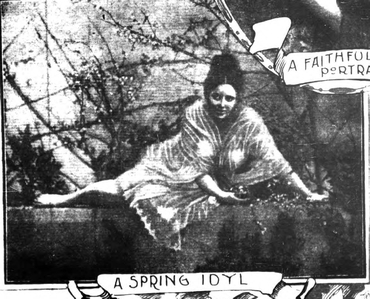 Dorothy Usner in A Spring Idyl, from New York World (Potentially naughty) Image courtesy of Old Fulton NY Post Cards
|
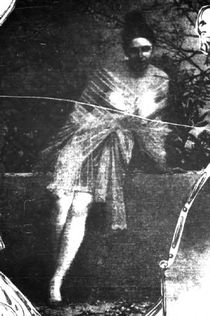 Dorothy Usner Among the Almond Blossoms, from New York World (Potentially naughty) Image courtesy of Old Fulton NY Post Cards
|
What is the relevance of this story to the history of motion pictures in Australia? As it turns out some important information has come to light.
When he states that H. Walter Barnett was in Australia taking photographs of Dorothy Usner and arranging window displays, Cato contradicts his own assertion (on page 116 of his book) that Barnett and Marius Sestier met in India: the period Ms Usner was in Australia included precisely the time Barnett would had to have been in India or travelling thereto or therefrom to coincide with Sestier's time there.
During the last week of Nat Goodwin's company's Melbourne season Carl Hertz, on 22 August 1896, showed projected motion pictures to the Australian public for the first time, at Melbourne's Opera House.
Goodwin's company played in Sydney at the Lyceum Theatre, and it was there that Marius Sestier gave two private shows of the Lumière cinematographe before getting a regular exhibition venue, the Salon Lumière, across the road from that theatre.
One serendipitous discovery is the following. One of Barnett's photographs published in the New York World on 27 June 1897 shows Dorothy Usner dressed in pierrot costume, which almost exactly matches that seen in an advertising card for the Salon Lumière, which opened at 237 Pitt St, Sydney on 28 September 1896 (coincidentally the date on which she departed from Australia). (The World image has been considerably retouched.) The Salon Lumière was part-managed by Barnett, and following his photographic sessions with Usner in Melbourne, he obviously decided to utilise her talents to advertise his new venture. Was the advertising card released in volume in this form? The primary function of the Salon Lumière was to show motion pictures with the newly-arrived Lumière cinématographe (brought to Australia by Marius Sestier). But curiously, "CINEMATOGRAPHE" does not have its terminal "E" in the photograph: might this have been enough to reject the card (in this exact form) for advertising purposes?
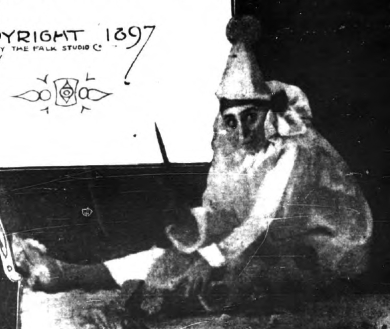 Dorothy Usner as a pierrot, from New York World Image courtesy of Old Fulton NY Post Cards
|
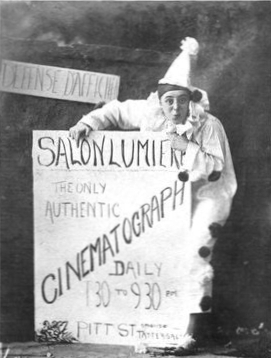 Salon Lumière ad. with pierrot Image courtesy of the
National Film and Sound Archive of Australia |
Maybe the space that carries the copyright notice in the photograph on the left above, in the original showed an advertisement for the cinématographe?
Dorothy Usner was obviously very pleased with the design of a pierrot showing a placard for a show because she later produced a poster with the same motif for the play Why Smith Left Home, in which she appeared in the USA and in London:
|
Copyright © 2011 – 2024 Tony Martin-Jones | FILM HISTORY INDEX |
Edition 2·1 (2024-11-24) [First edition in 2011-11] |
